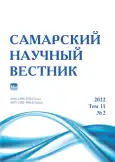The nidicolic group of gamase mites on the territory of Eastern Transbaikalia and their biocoenotic relationships
- Authors: Poletaeva T.G.1, Kleusova N.A.1, Larina N.P.1, Chistyakova N.S.1, Plyaskina I.N.1
-
Affiliations:
- Chita State Medical Academy
- Issue: Vol 11, No 2 (2022)
- Pages: 113-119
- Section: Biological Sciences
- URL: https://journals.rcsi.science/2309-4370/article/view/109838
- DOI: https://doi.org/10.55355/snv2022112116
- ID: 109838
Cite item
Full Text
Abstract
This paper summarizes the results of studies on the fauna of gamas mites of the nidicolic group. On the Eastern Transbaikal Territory, 68 species have been identified as part of the nidicolic group. They belong to nine families, most of them have been found in rodent nests. The largest number of species belongs to the families Parasitidae, Laelaptidae, Rhodacaridae. Many species have been found in the soil, where they form micropopulations. Of the 68 species 19 have not been found in the soil: six species of Euryparasitus, three species from the genera Poecilochirus, Ameroseius, Macrocheles, one species – Parasitus (Coleogamasus) tichomirovi, Veigaia beklemischevi, Pachylaelaps siculus, Hypoaspis krameri. In the biocoenosis of the vegetable storage, H. timofejevi have had the highest rates, its reproduction and development have taken place here. We have detected all stages of development. The main parts of the population have been represented as follows: females – 48%, males – 11,8%, larvae – 1,2%, protonymphs – 7%, deutonymphs – 32%. Females in each hamazid population numerically have predominated over males. Drawings of the preimaginal stages of development as well as its topical and phoric connections have been described. The nidicoles of the forest-steppe zone of Transbaikalia have demonstrated a tendency to synanthropization. The tendency has been noted in 21 species of nidicoles from six families: eight from the family Parasitidae, five from the family Laeleptidae, three from the family Macrochelidae, two species from the family Ameroseidae, Aceosejidae and one species from the family Rhodacaridae. Interspecific relationships have been established for H. timofejevi, E. emarginatus.
Full Text
##article.viewOnOriginalSite##About the authors
Tatyana Grigorevna Poletaeva
Chita State Medical Academy
Email: t.poletaeva@chitgma.ru
candidate of biological sciences, senior lecturer of Biology Department
Russian Federation, ChitaNadezhda Aleksandrovna Kleusova
Chita State Medical Academy
Email: kleusova.nadezhda@yandex.ru
candidate of biological sciences, senior lecturer of Biology Department
Russian Federation, ChitaNataliya Petrovna Larina
Chita State Medical Academy
Email: nat15398723@yandex.ru
candidate of biological sciences, head of Biology Department
Russian Federation, ChitaNataliya Sergeevna Chistyakova
Chita State Medical Academy
Email: chistyacovans@mail.ru
candidate of biological sciences, associate professor of Biology Department
Russian Federation, ChitaIrina Nikolaevna Plyaskina
Chita State Medical Academy
Author for correspondence.
Email: thebestdamnthing@mail.ru
assistant of Biology Department
Russian Federation, ChitaReferences
- Гончарова А.А. Гамазовые клещи Восточной Сибири: автореф. дис. … д-ра биол. наук. Новосибирск, 1967. 40 с.
- Полетаева Т.Г. Свободноживущие гамазовые клещи лесостепной зоны Забайкалья и их экология: автореф. дис. … канд. биол. наук. Иркутск, 1998. 16 с.
- Определитель обитающих в почве клещей Mesostigmata / под ред. М.С. Гилярова. М.: Наука, 1977. 718 с.
- Сорокопуд И.А., Симак С.В., Бабаев Т.О., Кожевникова М.В. Фауна и экология гамазовых клещей мелких млекопитающих Самарской Луки // Наука. Творчество: XI междунар. науч. конф. 3-6 апреля 2015 г. Т. 1. Самара: Изд-во Самарской государственной областной академии (Наяновой), 2015. С. 134-146.
- Никулина Н.А. Гамазовые клещи мелких млекопитающих Чарской котловины (Gamasoidea) // Паразитология. 1979. Т. 13, № 4. С. 418-422.
- Щербак Г.И. Особенности фауны гамазовых клещей гнезд береговой ласточки // Вестник зоологии. 1983. № 5. С. 49-52.
- Буякова Т.Г. Гамазовые клещи специальных мест хранения запаса продуктов в Забайкалье и Южном Прибайкалье: автореф. дис. … канд. биол. наук. Чита, 1970. 28 с.
- Гончарова А.А., Буякова Т.Г., Исакова Т.Г., Волкова Г.Н. Биоценотические связи некоторых видов гамазовых клещей из гнезд птиц Забайкалья // Фауна и экология наземных членистоногих Сибири: сб. науч. тр. / отв. ред. С.А. Кулик. Иркутск: ИГУ, 1981. С. 133-143.
- Исакова Т.Т. Гамазовые клещи птиц восточного Забайкалья: автореф. дис. … канд. биол. наук. Иркутск, 1968. 19 с.
- Лапиня И.И. Основные экологические группировки обитающих в почве гамазовых клещей // Пятое всесоюз. акарологическое совещ. Фрунзе, 1985. С. 184-186.
- Свидерский Л.П. Фауна клещей на продовольственных складах различного типа // Первое акарологическое совещ.: тез. докл. М.-Л., Наука, 1966. С. 182-184.
- Буякова Т.Г. Гамазовые клещи жилых помещений Восточной Сибири // Первое акарологическое совещ.: тез. докл. М.-Л., 1966. С. 46-47.
- Бондарчук К.В. Гамазовые клещи грызунов южной тайги и лесостепи Читинской области // Вопросы медицинской географии и курортологии. 1967. Вып. 1. С. 90-95.
- Бондарчук А.С., Цельников П.С. Стациальное распределение гамазовых клещей в Северо-Восточном Забайкалье // Пятое всесоюз. акарологическое совещ. Фрунзе, 1985. С. 42-44.
- Гончарова А.А., Буякова Т.Г., Полетаева Т.Г. Биоценотические связи почвообитающих гамазовых клещей в природных биоценозах и урбоценозах // Шестое всесоюз. совещ. по проблемам теоретич. и прикладной акарологии. Л., 1990. С. 37-38.
- Поршанов А.М., Яковлев С.А., Курняева А.Д. Гамазовые клещи мелких млекопитающих полупустынной зоны Саратовского Заволжья // Паразитология. 2017. Т. 51, № 2. С. 132-142.
- Полетаева Т.Г. Взаимоотношение свободноживущих гамазид с паразитическими клещами // Проблемы почвенной зоологии: мат-лы докл. X всесоюз. совещ. Новосибирск, 1991. С. 174.
- Полетаева Т.Г. Фауна и экология клеща Euryparasitus emarginatus в Забайкалье // I всерос. совещ. по проблемам почвенной зоологии. Ростов-на-Дону, 1996. С. 117-118.
- Гончарова А.А., Буякова Т.Г. Гамазовые клещи Euryparasitus emarginatus (C.L. Koch) в Восточной Сибири // Известия СО АН СССР: сер. биол.-мед. наук. 1964. Т. 4, вып. 1. С. 111-119.
Supplementary files











